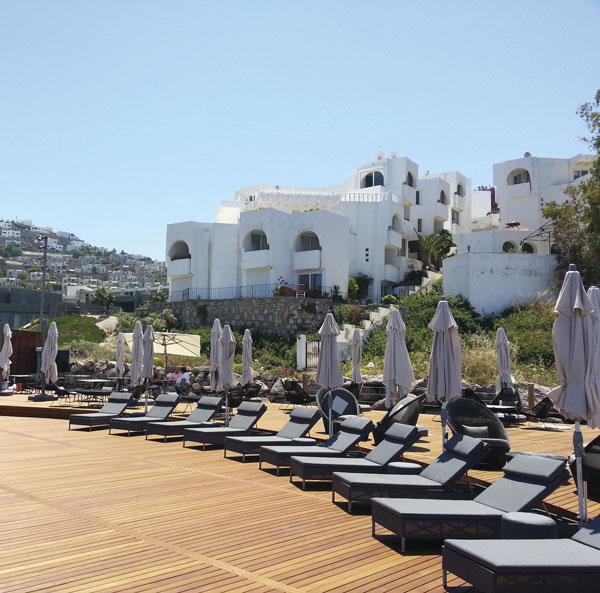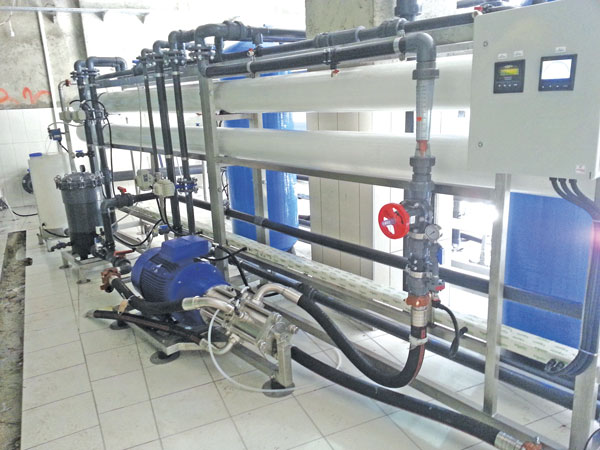More than 1 billion people live in arid regions with little to no access to freshwater. Two-thirds of Earth is covered in water, but 97 percent of this water is seawater. Land-based freshwater sources, from the developing world to more industrialized countries, have been nearly depleted as populations grow and demand increases.
Seawater desalination can address the world's demand for consumable water. For many countries, desalination is the only source of potable water. However, the equipment in the desalination process—from the pump to the motor—consumes vast amounts of energy.
Equipment efficiency is the key consideration in desalination plant design and operation because it ultimately determines the final cost of the water.
The core hydraulic system of a reverse osmosis (RO) plant is the high-pressure pump. This pump pushes pretreated seawater through a membrane at a pressure that exceeds osmotic pressure. Because of the higher power requirements, the pump accounts for most of the facility\'92s energy consumption and determines the system's overall efficiency.
A new technology combining a high-pressure pump, an electric drive, a booster pump and an energy-recovery device can save up to 75 percent of energy costs in reverse osmosis (RO) desalination plants.
How It Works
The combined pumping unit includes a lubricated free axial piston pump and an axial piston motor as an energy recovery device. The piston pump produces the water flow to the RO membrane. This flow depends on the engine speed and the pump's displacement volume.
he axial piston pump and the axial piston motor are connected through an axle driving shaft. When the redirected brine concentrate flows through the piston motor, it supports the electromotor in powering the piston pump.
The relation between the displacement volume of the piston pump and the piston motor is defined by the recovery rate. The operating pressure will be adjusted automatically by the membranes.
Energy Recovery
The combined pumping unit receives pretreated seawater with a concentration of about 40,000 parts per million (ppm) from a feed pump. The pressure center raises the seawater pressure from 36 to 1,015 psi and transfers the water into the RO membrane. The membrane separates the brine from the water to produce permeate.
 Modular design and energy efficiency are key characteristics for high-pressure pumps in desalination applications outside of the industrial sector, such as this seaside resort in Turkey. The modular desalination pumping unit will produce up to 70,000 gallons per day of freshwater for about 400 guests at the hotel. (Images courtesy of KSB)
Modular design and energy efficiency are key characteristics for high-pressure pumps in desalination applications outside of the industrial sector, such as this seaside resort in Turkey. The modular desalination pumping unit will produce up to 70,000 gallons per day of freshwater for about 400 guests at the hotel. (Images courtesy of KSB)
The resulting high-pressure brine returns to the pressure center where its mechanical energy is recovered. The recovered energy contributes to raising the pressure of the incoming pretreated seawater. The brine energy recovery system contributes to the high rates of energy efficiency during the process, with an energy consumption of less than 2 kilowatt-hours per cubic meter.
Modular Design
The international desalination industry has experienced growing demand for modular design desalination plants. Modular design allow hotels, resorts and even manufacturing sites to be independent of regional water supply companies. Modular reverse osmosis (RO desalination systems quickly and efficiently produce low-cost drinking water while saving space in facilities.
A modular RO pumping unit responds to international demand by combining several components into one. The unit's single axial piston motor serves as an integrated energy recovery device. The motor creates high pressure, compensates pressure losses and recovers energy. Because the system runs on a single electric motor and frequency inverter, a separate booster pump is not required.
By removing the need for a separate booster pump and motor, the number of components associated with other systems is reduced. Fewer components save on capital and installation costs, such as pipes between individual components, as well as maintenance and life cycle costs. When using this integrated system, the only other mechanical elements required are a seawater feed pump and a membrane.
In addition, the combined pumping unit functions without lubricants, instead using seawater. There is no fluid exchange between the feedwater and brine, avoiding energy-wasting mixing. By removing the need for conventional lubrication, the unit saves up to 150 tons of carbon-dioxide emissions per year.
Applications
A Turkish company recently ordered several combined pumping units to be used in a beachfront hotel. The units will produce up to 70,000 gallons per day of freshwater for about 400 guests.
In early 2013, a German company was awarded the order to supply and deliver an RO system with low operating costs to provide freshwater to feed cooling towers for an oil and gas company in North Africa. The high concentration of salt in the Red Sea required a high-pressure pump to desalinate the seawater and provide freshwater. The company needed a technology with low energy consumption and low cost of operation to produce consistent high-quality water.
The company built a cost-effective RO system equipped with combined pumping units with energy consumption of 2 kWh/m3. The energy recovery device reduced operational cost by 25 to 40 percent compared with conventional RO systems.


